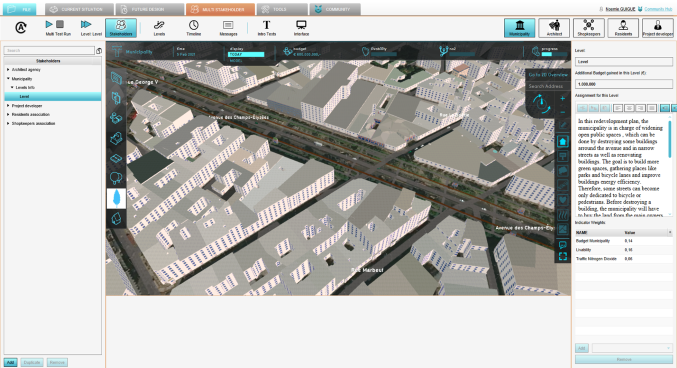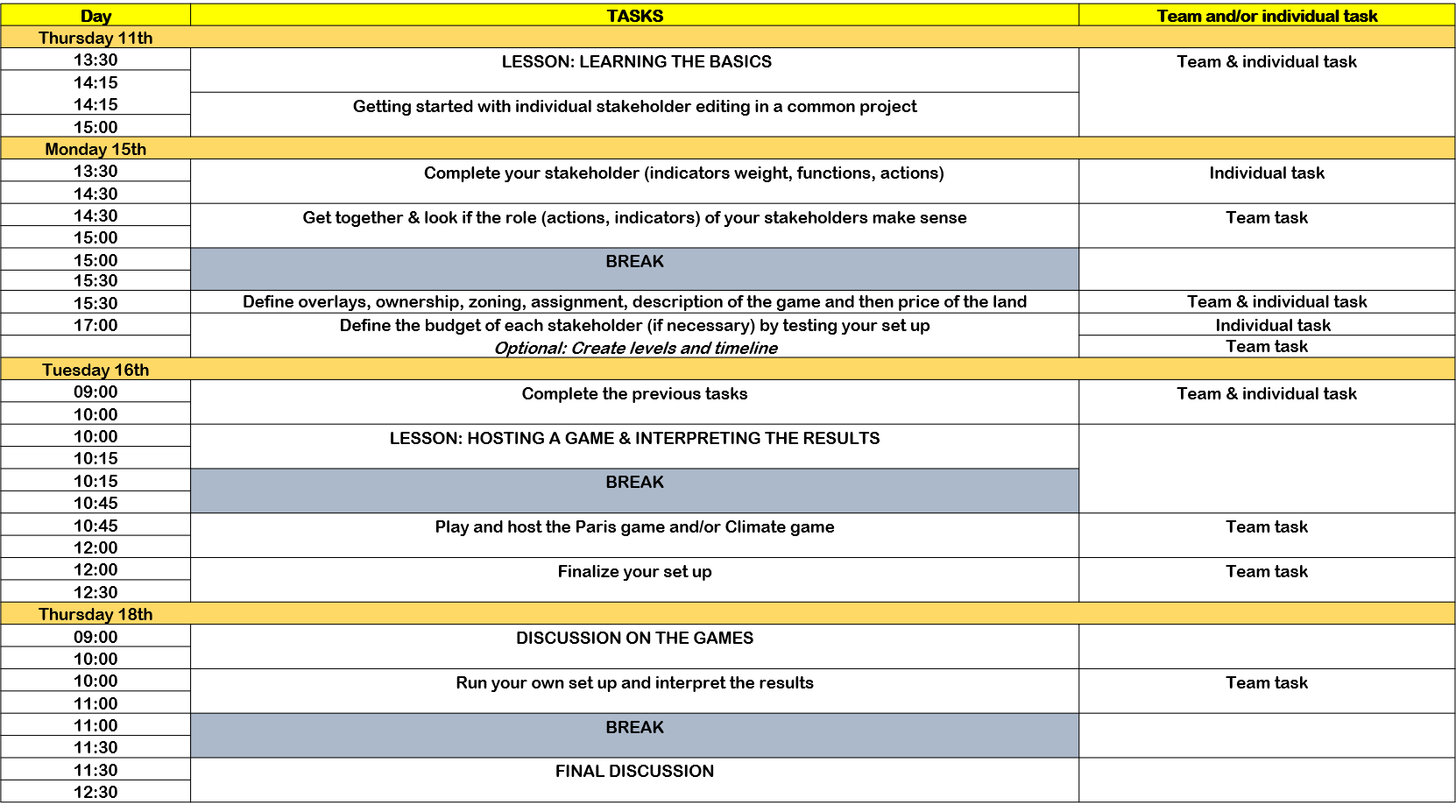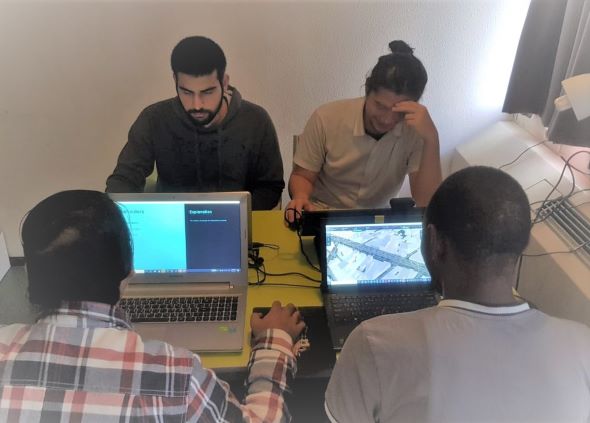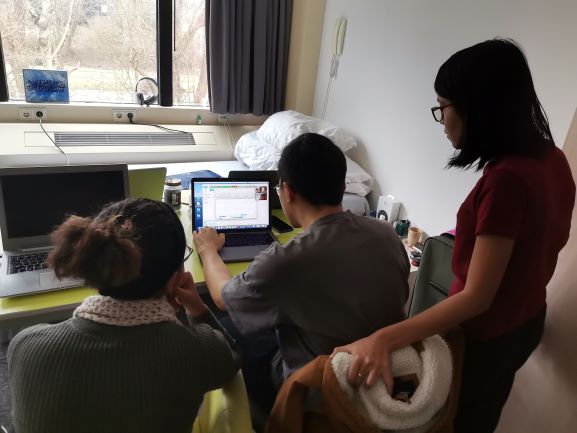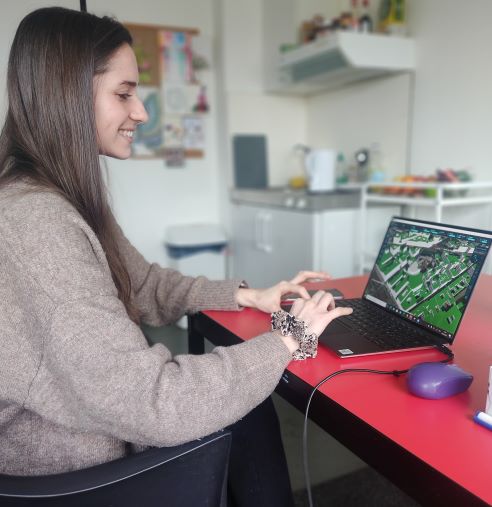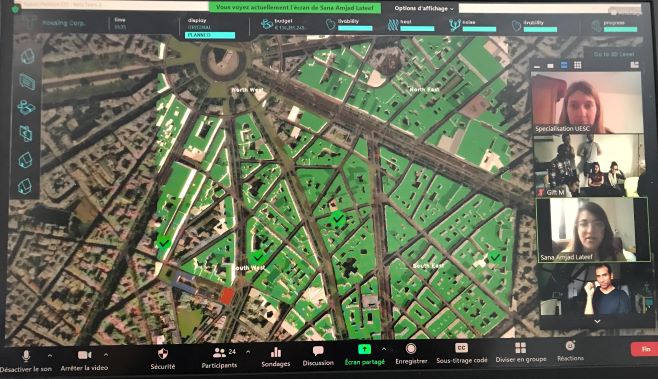Tygron for Decision-Making: Difference between revisions
No edit summary |
|||
| (52 intermediate revisions by 2 users not shown) | |||
| Line 1: | Line 1: | ||
=Use-case 5: ''“Scenario Building for Sustainable Cities”''= | =Use-case 5: ''“Scenario Building for Sustainable Cities”''= | ||
For a few years now, IHS has been using Tygron as a scenario building tool within its | For a few years now, IHS (Institute for Housing and Urban Development Studies) has been using the Tygron Platform as a scenario building tool within its "Urban Management Tools for Climate Change" short courses. During this course, the Tygron support team would join the students for half a day to guide them on the '''Climategame'''. Last year (2019-2020), [https://www.tygron.com/en/2020/05/15/ihs-integrated-the-tygron-platform-successfully-in-the-curriculum/ IHS decided to experiment with implementing the Tygron platform for one of its Master's specializations]. The course was given as an elective for 15 students, and the implementation was completely successful. This success has pushed IHS team to design and implement a mandatory course using Tygron as part of the new curriculum. Contrary to last year, due to the COVID-19 restrictions, the course was completely done online this year (2021). | ||
[[File:IHSclassroom.jpg|200px|frame|center|IHS students playing the Climate Game during the pilot Tygron course (2020)]] | |||
==Content of the course== | ==Content of the course== | ||
| Line 9: | Line 11: | ||
*'''Study-block''': "Applications of ICT for Smart and Sustainable Cities" | *'''Study-block''': "Applications of ICT for Smart and Sustainable Cities" | ||
*'''Study Programme''': Masters in Urban Environment Sustainability and Climate Change. | *'''Study Programme''': [https://www.ihs.nl/en/master/urban-environment-sustainability-and-climate-change/study-programme Masters in Urban Environment Sustainability and Climate Change]. | ||
*'''Educational Institute''': Institute for Housing and Urban Development Studies (IHS) of the Erasmus University Rotterdam. | *'''Educational Institute''': [https://www.ihs.nl/en Institute for Housing and Urban Development Studies (IHS) of the Erasmus University Rotterdam]. | ||
===Target students=== | ===Target students=== | ||
The course is designed for 30 students | *The course is designed for 30 students at the Masters level. | ||
The students are expected to have some knowledge in decision-making | *Students are international and come from different backgrounds. | ||
*The students do not have any prior knowledge of the Tygron platform or other geodesign software. | |||
*The students are expected to have some knowledge in decision-making. | |||
*No specific skill sets or tools are required upon entering this course. | |||
===Objectives and desired outcome=== | ===Objectives and desired outcome=== | ||
The students are expected to learn planning and decision making for sustainable cities in a multi-stakeholder environment. | The students are expected to learn planning and decision making for sustainable cities in a multi-stakeholder environment. | ||
To do that, the lecturer and the teaching assistant have created a model case study based on the Champs-Elysées area in Paris using Tygron | To do that, the lecturer and the teaching assistant have created a model case study based on the Champs-Elysées area in Paris using the Tygron platform. | ||
They called the model the "Paris Game". It is inspired by an existing redevelopment plan of the Paris municipality, with modified objectives. | |||
The students are expected to form teams of 4-5, and design scenarios for improving sustainability of a chosen or given area, while creating a multi-stakeholder decision making environment. | [[File:ParisGame1.png|200px|frame|center|The Champs-Elysées area in the Tygron platform. Model created by IHS.]] | ||
The students are expected to form teams of 4-5, and design scenarios for improving the sustainability of a chosen or given area, while creating a multi-stakeholder decision making environment. | |||
More-specifically, each team is expected to develop its own scenario for this area by: | More-specifically, each team is expected to develop its own scenario for this area by: | ||
* Creating a story; defining the | * Creating a story; defining the potentially involved stakeholders, their indicators, their goals, their budget, etc. | ||
* | * Simulating the interaction between stakeholders by playing the "game' as if it is a real-life situation. | ||
==Design of the Course== | ==Design of the Course== | ||
===Syllabus and | ===Syllabus and time distribution=== | ||
[[File:ParisGameSchedule.png|thumb|250px|right|Schedule of the course as designed by IHS.]] | |||
As mentioned previously, this course is part of a study-block, so it is designed to take place over 4.5 days. | As mentioned previously, this course is part of a study-block, so it is designed to take place over 4.5 days. | ||
The following steps explain how the course goes: | |||
#Before the beginning of the course, students are asked to form teams of 4-5 members. This is to avoid potential logistical problems. | |||
#On the first day, students get introduced to the assignment | |||
#Then, the teams start working on editing the projects with Tygron. | |||
#Every team is assigned to improve the livability and sustainability of one identical area (A section of Champs-Elysées street Paris). The case is inspired from [https://www.cbsnews.com/news/paris-mayor-pushes-ahead-with-plan-to-give-champs-elysees-a-305-million-green-makeover/ local government’s plan] for improving greenery in the neighbourhood. However, the goals are expanded in order to make the assignment more challenging. This also allows comparing the approach of different groups with a common aim of addressing sustainability challenges in the same area. | |||
#They start by defining the stakeholder roles, land pricing, goals, budgets, and indicators. | |||
#Later, they host a multi-stakeholder session, with each team member as a stakeholder. For this, they could choose the Climate Game, the Paris Game, or both. | |||
#On the last day, each team play another team's game on the Champs-Elysées area as a peer review. | |||
#At the end of the course, they go through a final discussion. | |||
<gallery caption= "IHS students working on their group assignments from home" mode="packed-hover" heights=250px> | |||
File:GroupworkingIHS.jpg | |||
File:GroupworkingIHS2.jpg | |||
File:GroupworkingIHS3.jpg | |||
</gallery> | |||
'''You can read more about the Paris case-study by downloading this document that IHS has created: [[File:Model case study Paris game.pdf|Model case study Paris game.pdf]].''' | |||
For | ===Guidance and resources=== | ||
For this course, lecturer Somesh Sharma and academic assistant Noémie Guigue created their own game. It took them around one month of research and preparation to get the Paris Game ready for the participants. | |||
====Preparation of the Paris Game==== | |||
#First, the lecturers selected a location to focus on. They selected a 1x1 km area of Champs-Elysées street. | |||
#They then went over the online support material including the wiki, the forum, the demo projects and video tutorials. | |||
#They found a relevant case-study that helped them develop the assignment | |||
#They prepared the project, by loading the location & relevant data into Tygron, and edited it using mostly functions like overlays, attributes, stakeholders and actions. | |||
#They got support from Tygron regarding ''the workload assessment, the course design, the learning activities'' as well as ''solving technical issues''. | |||
#In the end, they produced their own presentations to guide students on the proper use of the Tygron platform for the assignment. | |||
[[ | '''You can find the presentations here:''' | ||
#<u>[[file:IHS_ScenarioAnalysis_session1.pdf]]</u> | |||
#<u>[[file:IHS_ScenarioAnalysis_session2.pdf]]</u> | |||
It is also worth mentioning that this year (2021): | |||
*The presentations were delivered online. | |||
*The teams had to work remotely, so they had to consider the following in the formation of the teams: | |||
*#the proximity to other team members. Students living in the same student housing often worked together. | |||
*#the distribution of Windows and Apple-Mac laptops among team members. | |||
*#the CPU and memory power of laptops, in addition to the graphic cards. | |||
*Due to the corona measures, it was not possible to hold any interactive sessions inside the classroom. | |||
[[file:IHSTygron.jpg|350px|frame|center|IHS students discussing their projects]] | |||
==Outcome and Assessment== | ==Outcome and Assessment== | ||
===The course's outcome=== | |||
* The students achieved the course objectives: | |||
*# they learned “Scenario Building”. | |||
*# they learn about stakeholders’ consultation and participation in decision making. | |||
*# they learned about climate and sustainability indicators. | |||
*# they learned about the role of stakeholders and their interaction. | |||
In short, the outcome of the course has met the expectations. | |||
===Evaluation=== | |||
*Because the course is part of a study-block, the final assignment was not graded | |||
*The assignments were evaluated as part of the final discussion (peer-evaluation) | |||
*The overall performance of the students was good. Only a couple of groups were falling behind, however, they still managed to finish their assignments. | |||
==Feedback and Recommendations== | ==Feedback and Recommendations== | ||
'''According to the instructors of this course, these are the most relevant challenges:''' | |||
#Data unavailability could be a challenge, so it is recommended to: | |||
#*select an area and prepare it in advance. | |||
#*test the area, by doing the tasks that students will be required to do in advance. | |||
#*make sure it is ready to be used for the group-work. | |||
#Some students have problems understanding and following the scenario building steps in Tygron. | |||
#*To avoid that, systematic support should be provided for every working group through consultations and discussions. | |||
[[File:Last_session_Tygron.png|frame|center|IHS students working in teams from home during the lock-down (2021)]] | |||
'''Based on the experience with the course, the instructors also recommend:''' | |||
# Sparing around half a day to set-up the groups. | |||
# Distribute the students who have Apple-Mac laptops into different groups, since they often run into technical problems. | |||
# Giving students more time for completing the assignment. | |||
# Choosing a reachable location so that an excursion is arranged. | |||
# Involving a client or a guest lecturer in the course. For example, involving a representative from the municipality would be very helpful. | |||
<pre> | |||
"We are using Tygron as an example of (advanced) decision support tool for urban managers. | |||
Many institutes, specifically those who are providing education and research in the field of urban governance, urban design, sustainable cities planning, may find our approach relevant in their courses." | |||
Somesh Sharma (Lecturer of the course) | |||
</pre> | |||
==Contact== | |||
For more information about this course, you can contact us at: {{email}} | |||
You can also reach the coordinator of this course: [https://www.ihs.nl/en/about/ihs-staff/ihs-academic-staff/somesh-sharma Somesh Sharma], Lecturer and Workshop Coordinator of UESC at IHS: {{email|sharma|ihs.nl}} | |||
{|class="wikitable" style="margin: auto; background-color:#ffffcc;" | |||
| [[Tygron for Scientific Research|<<Previous page]] | |||
| [[Tygron EDU Manual|Back to Manual]] | |||
|} | |||
Latest revision as of 14:26, 22 September 2023
Use-case 5: “Scenario Building for Sustainable Cities”
For a few years now, IHS (Institute for Housing and Urban Development Studies) has been using the Tygron Platform as a scenario building tool within its "Urban Management Tools for Climate Change" short courses. During this course, the Tygron support team would join the students for half a day to guide them on the Climategame. Last year (2019-2020), IHS decided to experiment with implementing the Tygron platform for one of its Master's specializations. The course was given as an elective for 15 students, and the implementation was completely successful. This success has pushed IHS team to design and implement a mandatory course using Tygron as part of the new curriculum. Contrary to last year, due to the COVID-19 restrictions, the course was completely done online this year (2021).
Content of the course
General information
- Name of the course: "Scenario Building for Sustainable Cities"
- Study-block: "Applications of ICT for Smart and Sustainable Cities"
- Study Programme: Masters in Urban Environment Sustainability and Climate Change.
- Educational Institute: Institute for Housing and Urban Development Studies (IHS) of the Erasmus University Rotterdam.
Target students
- The course is designed for 30 students at the Masters level.
- Students are international and come from different backgrounds.
- The students do not have any prior knowledge of the Tygron platform or other geodesign software.
- The students are expected to have some knowledge in decision-making.
- No specific skill sets or tools are required upon entering this course.
Objectives and desired outcome
The students are expected to learn planning and decision making for sustainable cities in a multi-stakeholder environment.
To do that, the lecturer and the teaching assistant have created a model case study based on the Champs-Elysées area in Paris using the Tygron platform.
They called the model the "Paris Game". It is inspired by an existing redevelopment plan of the Paris municipality, with modified objectives.
The students are expected to form teams of 4-5, and design scenarios for improving the sustainability of a chosen or given area, while creating a multi-stakeholder decision making environment.
More-specifically, each team is expected to develop its own scenario for this area by:
- Creating a story; defining the potentially involved stakeholders, their indicators, their goals, their budget, etc.
- Simulating the interaction between stakeholders by playing the "game' as if it is a real-life situation.
Design of the Course
Syllabus and time distribution
As mentioned previously, this course is part of a study-block, so it is designed to take place over 4.5 days.
The following steps explain how the course goes:
- Before the beginning of the course, students are asked to form teams of 4-5 members. This is to avoid potential logistical problems.
- On the first day, students get introduced to the assignment
- Then, the teams start working on editing the projects with Tygron.
- Every team is assigned to improve the livability and sustainability of one identical area (A section of Champs-Elysées street Paris). The case is inspired from local government’s plan for improving greenery in the neighbourhood. However, the goals are expanded in order to make the assignment more challenging. This also allows comparing the approach of different groups with a common aim of addressing sustainability challenges in the same area.
- They start by defining the stakeholder roles, land pricing, goals, budgets, and indicators.
- Later, they host a multi-stakeholder session, with each team member as a stakeholder. For this, they could choose the Climate Game, the Paris Game, or both.
- On the last day, each team play another team's game on the Champs-Elysées area as a peer review.
- At the end of the course, they go through a final discussion.
- IHS students working on their group assignments from home
You can read more about the Paris case-study by downloading this document that IHS has created: File:Model case study Paris game.pdf.
Guidance and resources
For this course, lecturer Somesh Sharma and academic assistant Noémie Guigue created their own game. It took them around one month of research and preparation to get the Paris Game ready for the participants.
Preparation of the Paris Game
- First, the lecturers selected a location to focus on. They selected a 1x1 km area of Champs-Elysées street.
- They then went over the online support material including the wiki, the forum, the demo projects and video tutorials.
- They found a relevant case-study that helped them develop the assignment
- They prepared the project, by loading the location & relevant data into Tygron, and edited it using mostly functions like overlays, attributes, stakeholders and actions.
- They got support from Tygron regarding the workload assessment, the course design, the learning activities as well as solving technical issues.
- In the end, they produced their own presentations to guide students on the proper use of the Tygron platform for the assignment.
You can find the presentations here:
It is also worth mentioning that this year (2021):
- The presentations were delivered online.
- The teams had to work remotely, so they had to consider the following in the formation of the teams:
- the proximity to other team members. Students living in the same student housing often worked together.
- the distribution of Windows and Apple-Mac laptops among team members.
- the CPU and memory power of laptops, in addition to the graphic cards.
- Due to the corona measures, it was not possible to hold any interactive sessions inside the classroom.
Outcome and Assessment
The course's outcome
- The students achieved the course objectives:
- they learned “Scenario Building”.
- they learn about stakeholders’ consultation and participation in decision making.
- they learned about climate and sustainability indicators.
- they learned about the role of stakeholders and their interaction.
In short, the outcome of the course has met the expectations.
Evaluation
- Because the course is part of a study-block, the final assignment was not graded
- The assignments were evaluated as part of the final discussion (peer-evaluation)
- The overall performance of the students was good. Only a couple of groups were falling behind, however, they still managed to finish their assignments.
Feedback and Recommendations
According to the instructors of this course, these are the most relevant challenges:
- Data unavailability could be a challenge, so it is recommended to:
- select an area and prepare it in advance.
- test the area, by doing the tasks that students will be required to do in advance.
- make sure it is ready to be used for the group-work.
- Some students have problems understanding and following the scenario building steps in Tygron.
- To avoid that, systematic support should be provided for every working group through consultations and discussions.
Based on the experience with the course, the instructors also recommend:
- Sparing around half a day to set-up the groups.
- Distribute the students who have Apple-Mac laptops into different groups, since they often run into technical problems.
- Giving students more time for completing the assignment.
- Choosing a reachable location so that an excursion is arranged.
- Involving a client or a guest lecturer in the course. For example, involving a representative from the municipality would be very helpful.
"We are using Tygron as an example of (advanced) decision support tool for urban managers. Many institutes, specifically those who are providing education and research in the field of urban governance, urban design, sustainable cities planning, may find our approach relevant in their courses." Somesh Sharma (Lecturer of the course)
Contact
For more information about this course, you can contact us at:
You can also reach the coordinator of this course: Somesh Sharma, Lecturer and Workshop Coordinator of UESC at IHS:
| <<Previous page | Back to Manual |

